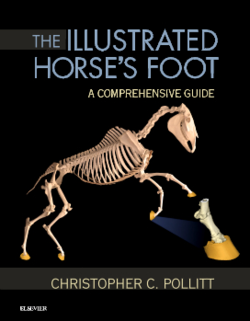Book Review: The Illustrated Horse's Foot, Pollitt, 1st Edition
The Illustrated Horse's Foot is divided into two sections - the structure and function of the foot followed by conditions of the foot. The structure and function of the foot is broken down into 13 chapters which address gross and microscopic structures. It also includes notes on radiographic imaging including venography. The text starts with the outer most structures and works inwards, all of which are beautifully illustrated with a combination of photographs, scanning electron micrographs, clear histological images, and computer generated 3D modelling.
The second section is comprised of 7 chapters, each one dedicated to a common condition of the foot from laminitis to infected nail holes. There is some variation with regard to the depth with which the conditions are undertaken with some are illustrated well with the use of multiple case studies, others are presented as a brief overview.
For those with an interest in learning more about the horses hoof, this book covers anatomy in far more detail than a general veterinary anatomy text book does and as such can be a useful resource for veterinary medicine/nursing, equine science and farriery students who may be seeking a more in depth understanding of the complex configuration of the horse foot.
The book uses lay terms for much of the surface anatomy, which may initially be confusing for those without an equine background but offers the chance for those readers to gain an understanding of the language commonly used by the equine community. The more detailed anatomical language used is generally academic which may make this a challenging read for horse enthusiasts without a science background but the comprehensive images do much to help overcome this. The preface suggests this is something the book has set out deliberately to achieve.
"People who care about horses and especially their feet come from all walks of life. They need to be well educated, but can be self-taught through reading and learning from others. An ability to think in pictures (like Einstein) rather than in the abstract is vital". Chris Pollit.
| This book was reviewed by: Date reviewed: March 2016 |
Error in widget FBRecommend: unable to write file /var/www/wikivet.net/extensions/Widgets/compiled_templates/wrt662efc33a0d975_34039227 Error in widget google+: unable to write file /var/www/wikivet.net/extensions/Widgets/compiled_templates/wrt662efc33a42db0_63265034 Error in widget TwitterTweet: unable to write file /var/www/wikivet.net/extensions/Widgets/compiled_templates/wrt662efc33a725b6_39367114
|
| WikiVet® Introduction - Help WikiVet - Report a Problem |
